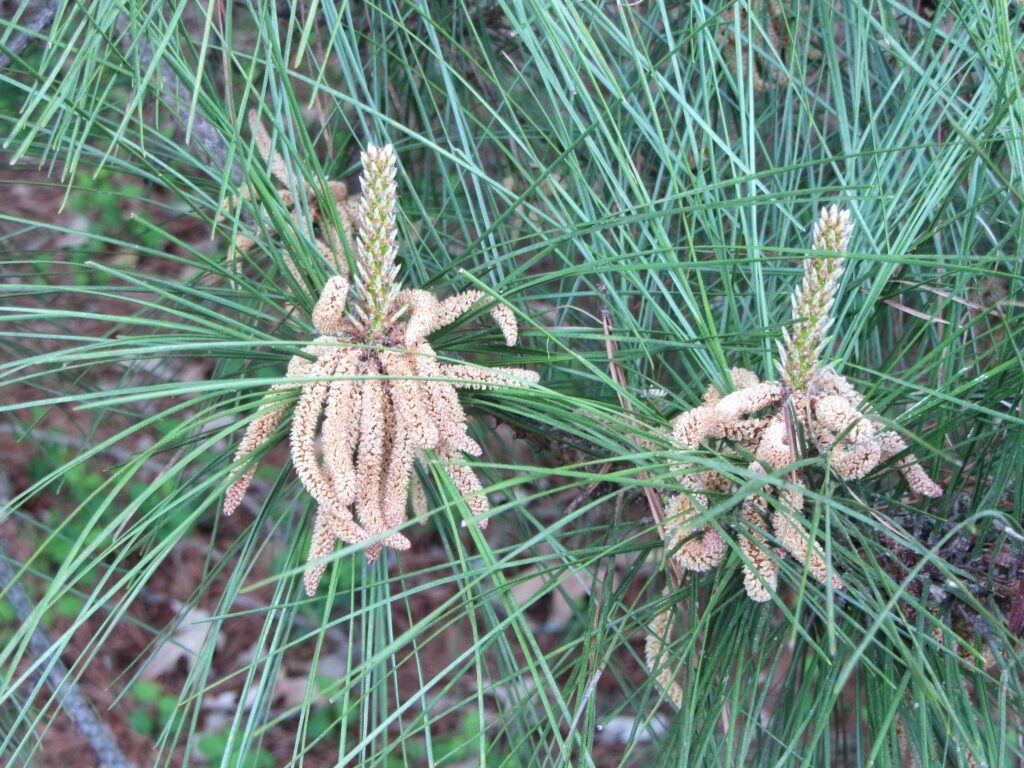Hedges and Hedgerows Part 2: Making Good Choices
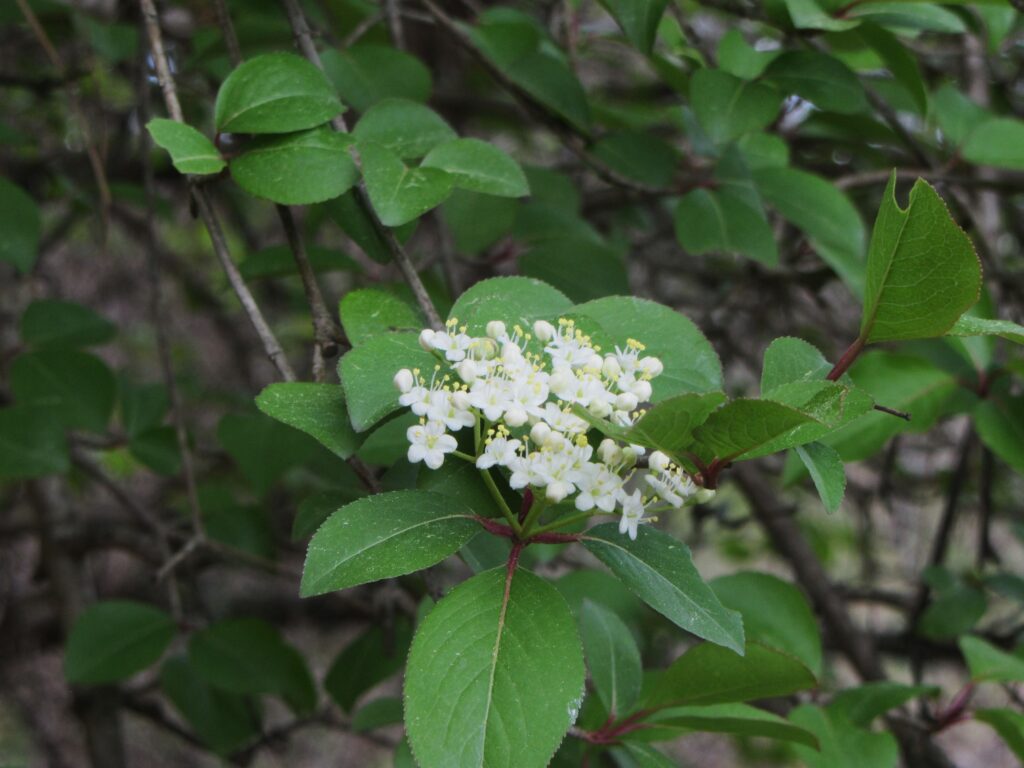
Viburnum cassinoides, Blue Haw Viburnum, grows along the banks for the James River near Jamestown Island.
Planting Reliable Shrubs in Tough Conditions
Home builders and contract landscapers rely on tried-and-true shrubs that they expect to out-live their warranty. That doesn’t mean that they are planting the most beautiful shrubs in new neighborhoods, or even the most appropriate ones for the site. They certainly don’t try to replace the sorts of native shrubs that might have grown on the site before it was razed for construction. But they choose reliable shrubs that they expect prospective buyers will recognize.
In most cases, home builders strip off the original soil, anyway, leaving compacted subsoil covered in roll-out turf. That isn’t the best beginning for a new hedge or young tree. If you choose an older home, you may soon discover that your yard is landscaped with several plants that are now on the ‘Invasive Species’ list for our area. That is because the very species that landscapers relied on decades ago were sturdy enough to take root, and then escape cultivation to colonize nearby areas. Trees and shrubs that produce any sort of tasty drupe or other fruit may be spread by the birds who find them. When too many of just a few species are planted in a small area, is it any wonder that those that are successful, persistent, and fertile will naturalize?
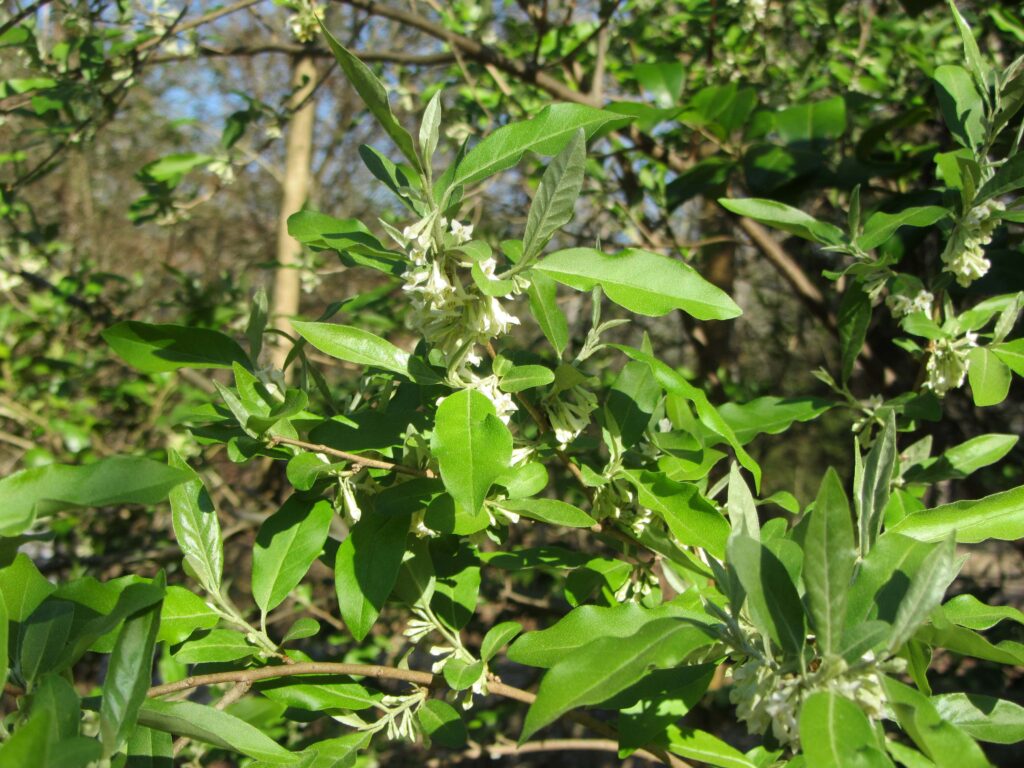
Autumn olive, planted many decades ago in many suburban yards, grows into a small tree. it is covered with flowers in mid-March and will bear thousands of edible fruits by autumn. Despite benefits to wildlife, this shrub is now considered invasive throughout Virginia and neighboring states.
Old Favorites, Now Scorned
As we became better acquainted with the shrubs in our ‘new’ mid-century Williamsburg yard, we discovered that many of those the birds prefer are now considered ‘invasive.’ Autumn olive, burning bush, Nandina, and Ligustrum grow throughout our community. Even if the builder or an earlier owner didn’t plant them, the birds probably have seeded them in years past. As I walked around a new neighbor’s yard with them soon after they closed on their property, we came upon an entire hedge of thick Nandina covered in bright red berries, growing along the shady side of their home. While not yet officially listed as ‘invasive,’ this shrub has gone out of fashion because of its very poisonous drupes.
When the time comes to replace older shrubs or add new woody landscaping, the many types of plants available can feel overwhelming. Knowing the conditions in your yard is a great way to narrow down the choices to only those that will grow well and meet your needs. Begin with a good walk around the yard at various times of day. Notice when the area is sunny and for how long. Notice whether water pools and stands after a rain. Notice the quality of the soil, and how other plants are growing. Have a soil sample analyzed to determine the pH and other things about your soil if the shrubs you want to plant, like Azaleas, have specific needs.
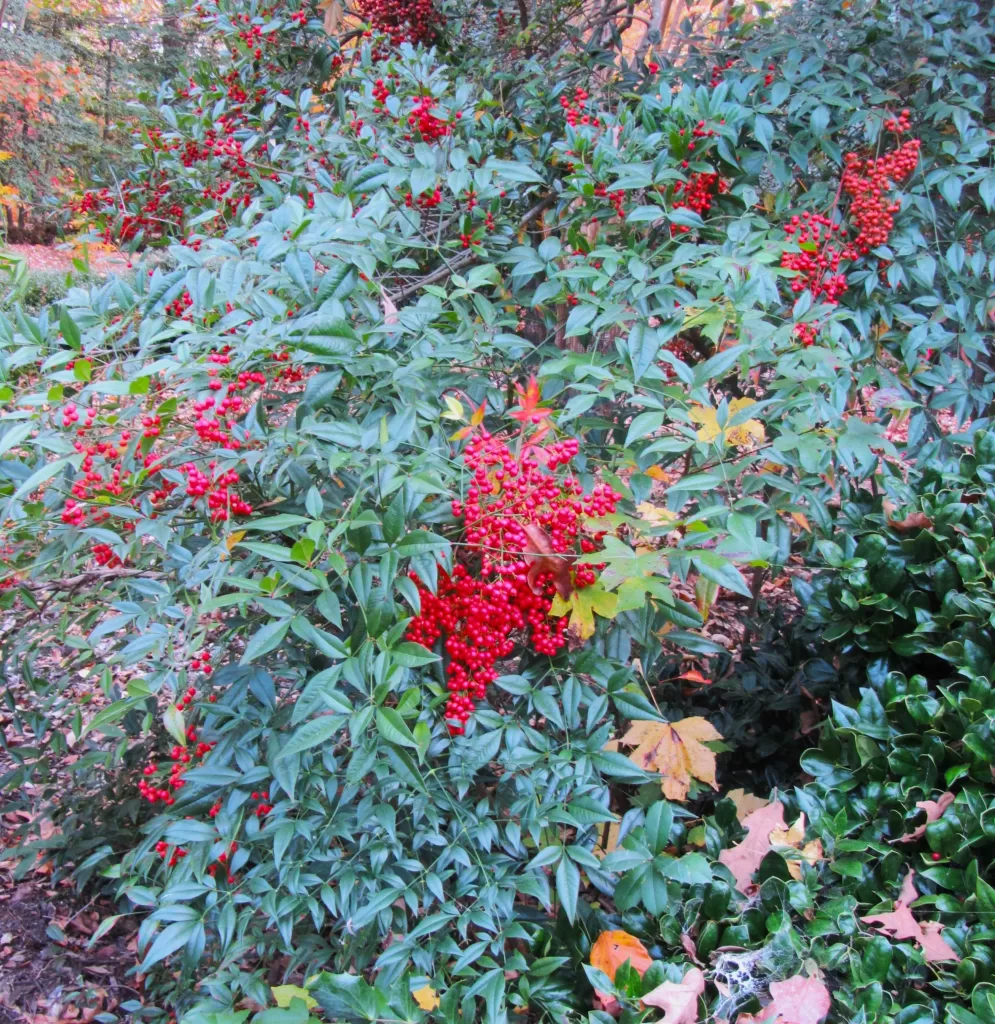
Nandina, or heavenly bamboo, is now considered a nuisance plant in some areas and invasive in others. Its fruits are extremely poisonous. Holly is a good substitute for those who choose to replace these shrubs.
How Does Your Garden Grow?
Most trees and shrubs thrive in full sun, which means more than six hours of direct sunlight on clear days. Full sunlight encourages compact growth and good flower and fruit production. New neighborhoods don’t usually have much shade from mature trees, so the original plantings need to be able to tolerate many hours of sunlight, usually without irrigation.
Favorite heirloom flowering shrubs like Rhododendrons and Azaleas, Camellias, mountain laurel, and Hydrangeas generally prefer partial sun to shade. Too much sunlight, especially in the winter, can burn their foliage. Plant these in the shade of a structure or fence, or under mature trees. Pay attention to the information about what each plant you consider needs so you can match the ‘right plant to the right place.’
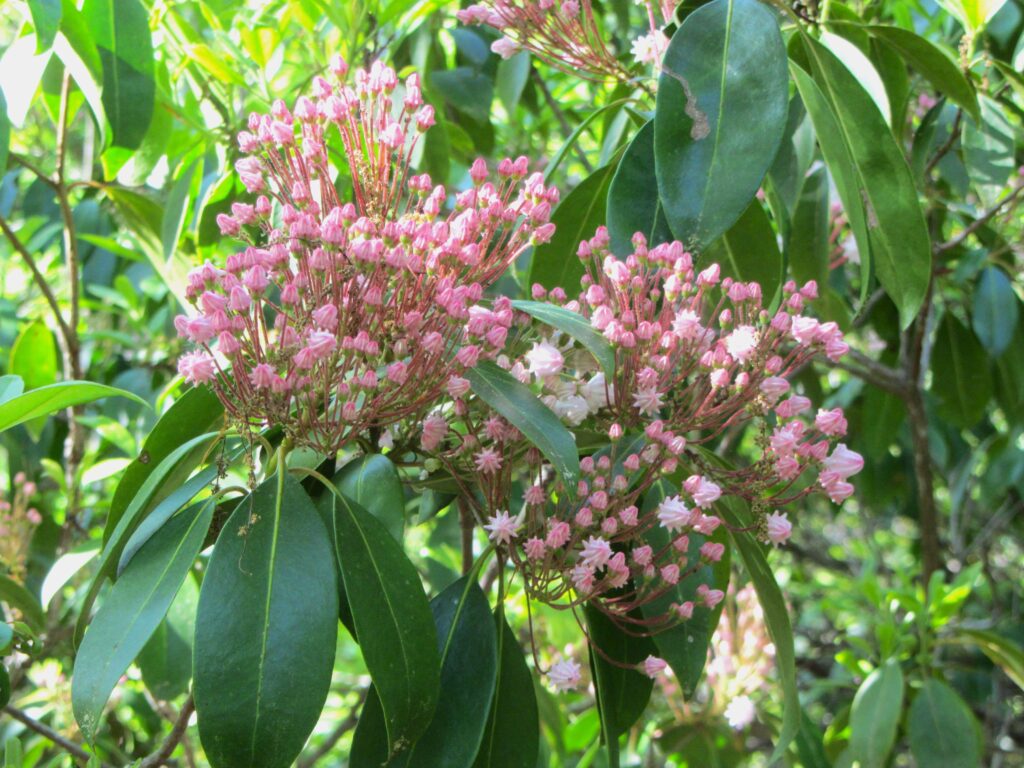
Mature mountain laurel shrubs in our yard most likely predate when our home was built. They grow in the shade of mature oak trees and form a dense thicket of more than a half-dozen shrubs. Mountain laurel wants excellent drainage to thrive.
If you are planting in a low spot where water pools, or on heavy clay soil, you will need to improve the drainage for many woody species to thrive. When woody roots sit for too long in saturated, heavy soil, without air available to the roots, root rot can set in and eventually kills the plant. While some shrubs don’t mind occasional wet soil, others will simply fail to thrive for months or years before they die.
How to Plant a Shrub
Fix poor drainage by planting shrubs in large containers, in a raised bed, or on a berm. Or choose varieties that can handle the wet soil. Most woody plants want to be planted a little ‘high,’ with the ‘crown’ where roots meet trunk at or slightly above the surrounding ground level. Always mulch new plantings but keep the mulch a few inches away from the trunk or main woody stems of your new shrub to protect it from voles, from insects in the mulch, and from diseases that can develop when the bark remains wet over a long time. Some landscape contractors pile mulches up around the trunks of trees and this endangers the tree’s health. If this happens in your yard, pull the mulch back, away from the bark of your tree.
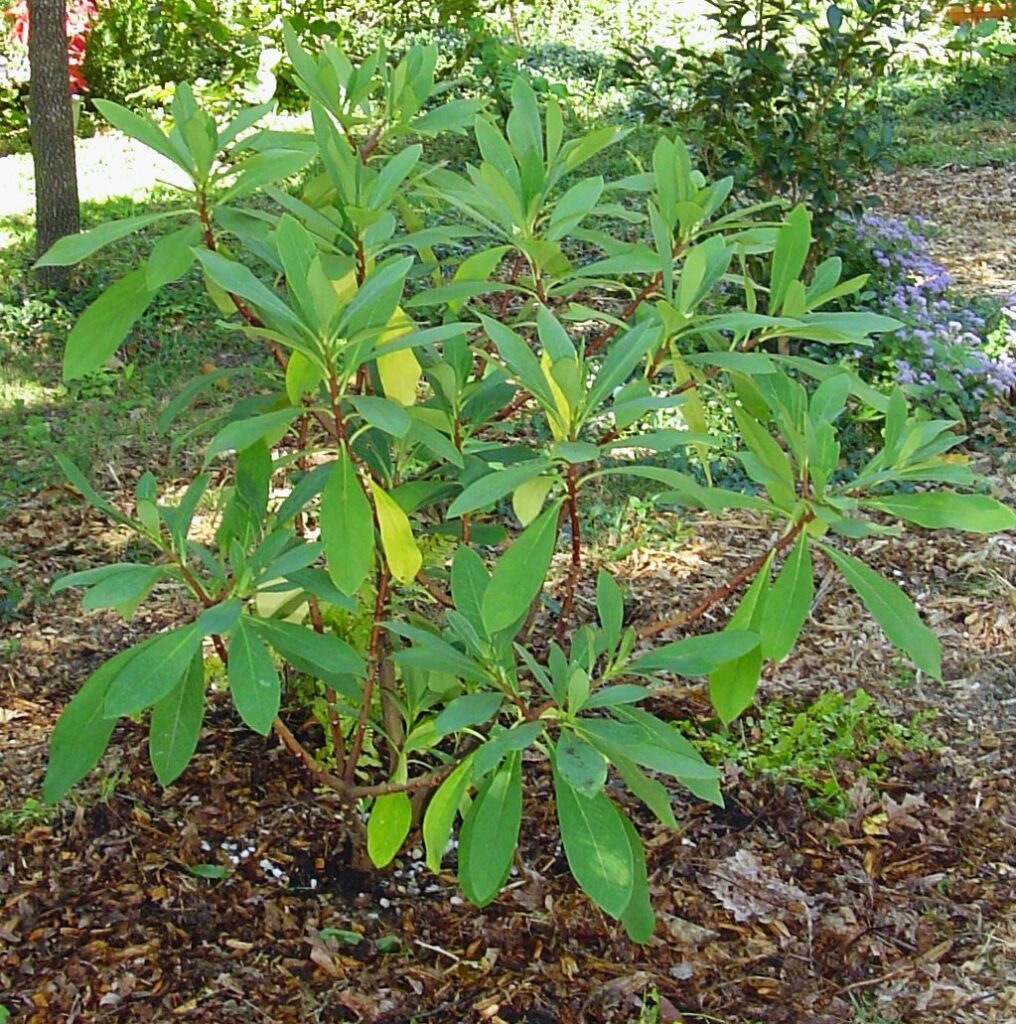
Edgeworthia chrysantha, Paperbush, mulched after planting in September 2013. This shrub blooms all winter with showy cream colored flowers.
Some gardeners want to amend poor soil with compost and other additives to improve it and to increase drainage. Where the amended soil meets the native soil, a barrier may develop making it harder for roots to penetrate and expand as the plant matures. Dig the planting hole twice as wide as the root ball and at the same depth. Most experts now agree that the back-fill soil in the planting hole should be broken up but not amended. Instead, mulch the newly planted shrub with compost or wood chips that will decompose to improve the soil over time. Always mulch new plantings beyond the drip line of the widest branches of the shrub, but remember to keep that mulch a few inches away from the trunk or main woody stems of your new shrub.
Accounting for Change
While there are many great choices of shrubs and small trees that thrive in our area, some traditional choices, particularly conifers, are rated for Zone 6 or 7 and northwards. They thrive in areas with colder winters and cooler summers than ours. Our area has been growing warmer in all seasons in recent decades, and we are now designated as Zone 8a by the USDA. Hot, muggy weather in the summer may be too much for conifers that prefer a cooler climate. As the plant struggles, particularly on summer nights that never cool off, various diseases can set in. Pay attention to heat tolerance when selecting plants as well as to their cold tolerance. Plants that thrive in Zones 5-9 will perform well in our climate.
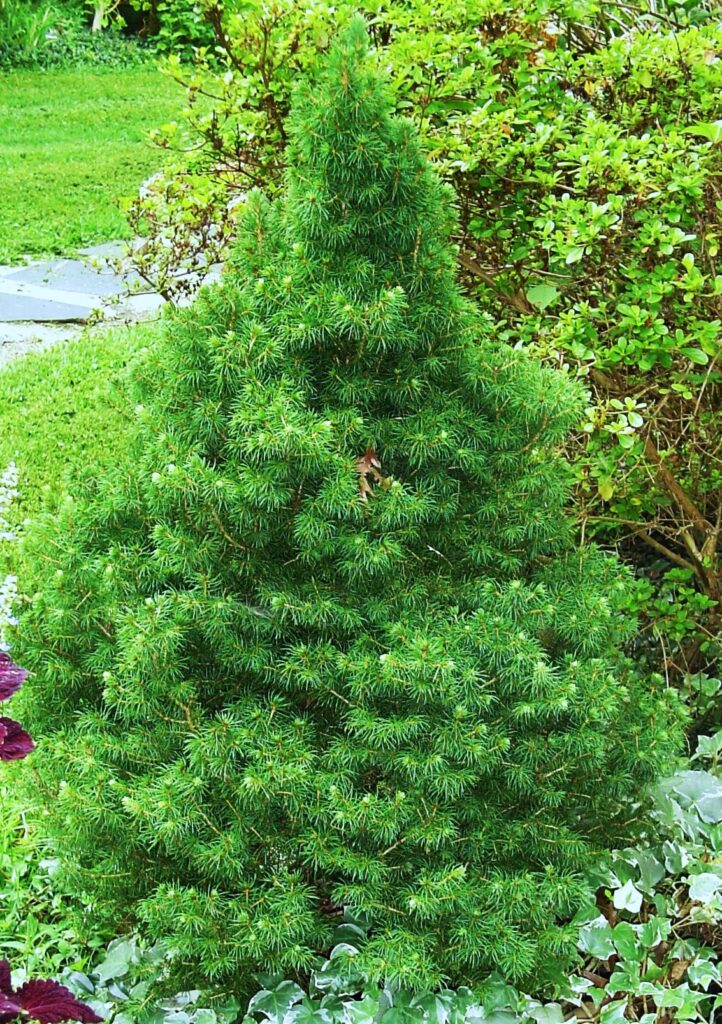
Common evergreen shrubs often prefer a cooler climate. This shrub was already growing in our yard when we came to the garden and has doubled in size over the years. Check the USDA climate information when buying a conifer shrub to make sure it can thrive in our Zone 8b summer heat.
Careful site evaluation, and a little research into the shrub and tree varieties available to you, will result in a successful landscaping project. There are hundreds of good trees and shrubs to plant around our homes. Most serve a specific purpose and grow best in a particular environmental niche. Dr. Michael Dirr’s Encyclopedia of Trees and Shrubs, listed in the bibliography, gives excellent guidance about recommended named selections and cultivars that perform well in our region. Dr. Dirr is on faculty at the University of Georgia.
Whether we are replacing older shrubs, revitalizing a hedge; or planting a new hedge, foundation planting, or hedgerow; we can enjoy a beautiful woody plant for many years to come. The purpose of this article is to provide ideas and guidance to help a homeowner begin their research and make confident decisions when investing in woody plants for their yard. This list is not meant to include every good choice. Rather, it highlights a few good and popular choices in each of several categories you may want to grow in your own yard. General information is given about selected genera with links to more detailed information online.
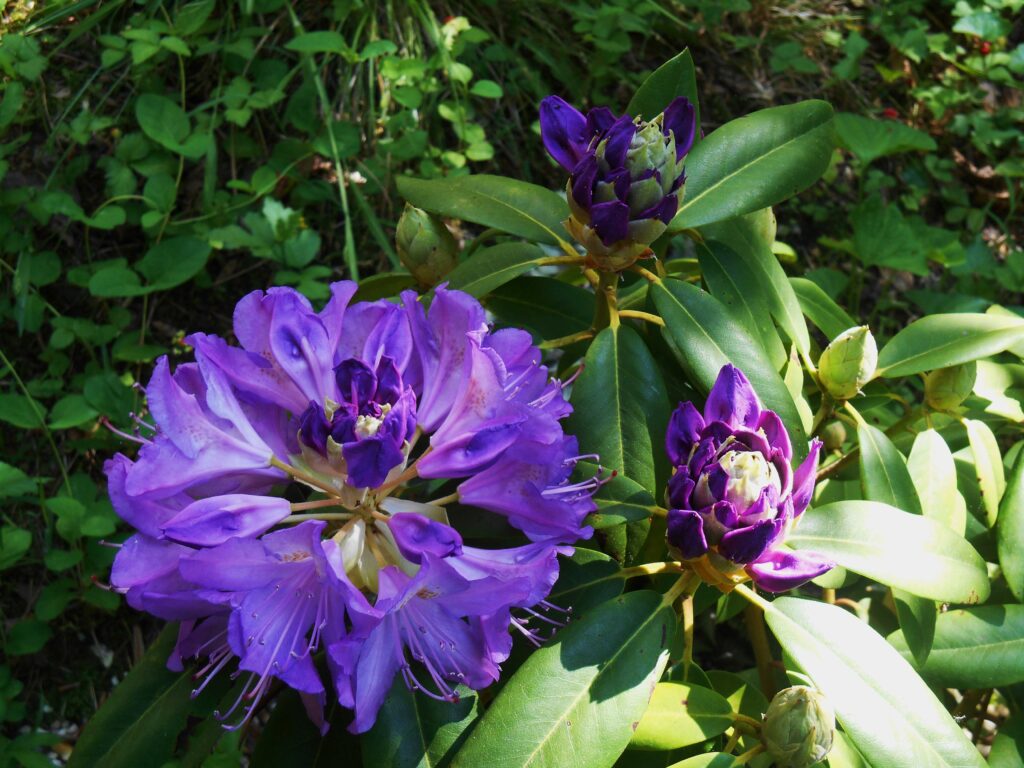
Rhododendron blooms in April and May.
You may also be interested in Hedges and Hedgerows for a Healthier and More Peaceful Life, Part 1
The categories:
Evergreen Conifers, Evergreen Flowering Shrubs, Evergreen Shrubs with Insignificant Flowers, Deciduous Flowering Shrubs, Popular but Invasive Shrubs
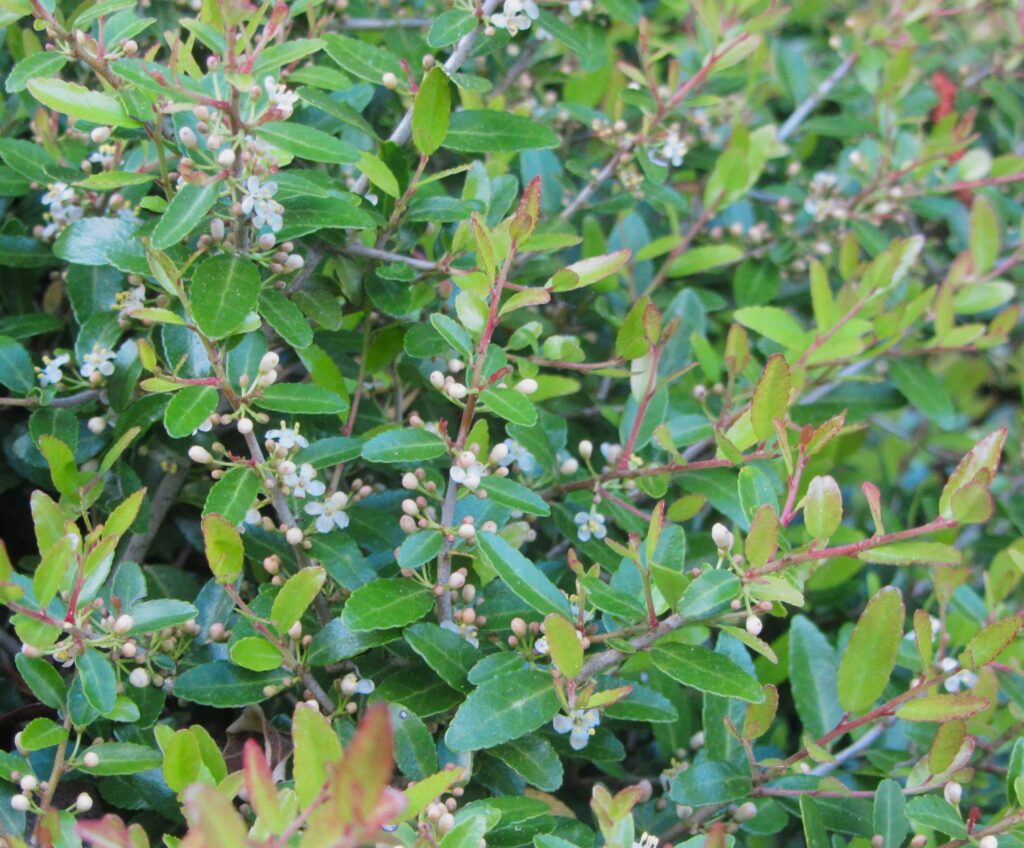
‘Schilling’s Dwarf’ yaupon holly blooms in late April. Since it is a male cultivar of Ilex vomitoria, it can fertilize other yaupon holly plants but will not produce berries or seedlings.
Abbreviations:
FS- full sun, PS, part sun, Sh- shade
DT- drought tolerant, Dr-needs good drainage, WS-tolerates wet soil
N-native in our area, WF-wildlife friendly
Evergreen Conifers
Chamaecyparis Cypress FS, Dr, DT, WF These very ornamental evergreens are tolerant of a wide variety of conditions and many selections tolerate hot summers. Some species will tolerate occasionally wet soil. Cypress provide good habitat and food for wildlife. The wide variety of sizes, forms and colors available make it easy to select shrubs that won’t need regular pruning or other care.
Juniperus Juniper FS, DT, Dr- These evergreens come in a variety of colors from gold to blue. Sizes vary from ground cover to large trees. Most want a cooler climate, so make sure selections can tolerate the heat of Zone 8b-9. Some species are native in our area, particularly Eastern red cedar.
Pinus ssp. (and) Pine FS, Dr, DT, WS, WF, some N While most pine species grow into large trees, there are dwarf varieties available for some species. Pines have needles of varying lengths and produce noticeable cones. Most are in shades of green to blue. Native species like loblolly and Virginia pine are more tolerant of heat than many Asian or Pacific Coast species.
Taxus Yew FS, PS, Dr, WS, N All parts poisonous Yew is a traditional evergreen shrub often associated with cemeteries and church yards. It remains dark, glossy green all season, producing berry like cones that are highly poisonous to people and pets. This is a very long-lived, tolerant shrub that thrives in difficult conditions and will take frequent pruning.
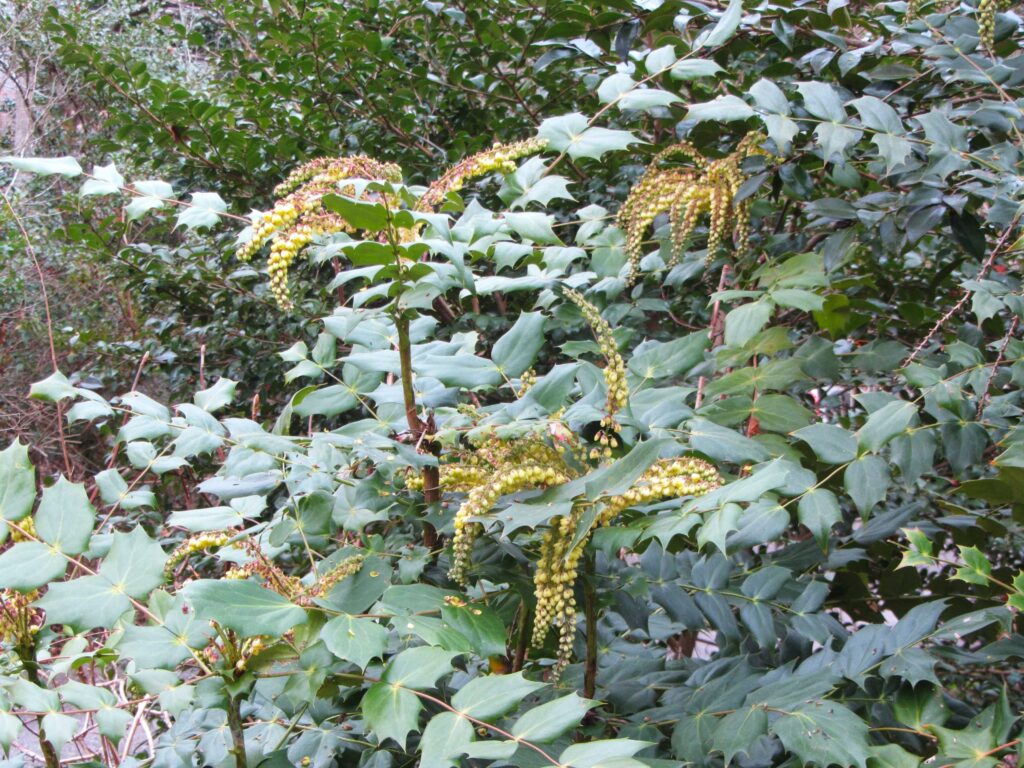
Berberis aquifolium blooms in winter, supporting pollinators on warm days. Its leaves may turn scarlet in exceptionally cold winters. Its drupes that ripen in May are edible.
Evergreen Flowering Shrubs
Linnaea (Abelia) FS, PS, Dr, MS, WF Often known as glossy Abelia, this heirloom Asian shrub, introduced in the late 19th century, remains evergreen in our area and blooms all summer with small, trumpet shaped white or pink flowers highly attractive to pollinators. Several selections and cultivars are available, some dwarf. Recent introductions offer variegated foliage and other attractive features. This is a very low maintenance shrub which needs little attention, once established, other than occasional pruning to maintain its size and shape. Deer rarely touch Abelia.
Rhododendron and Azalea PS, SH, MS, Dr, N, WF, all parts are poisonous if ingested. Rhododendrons bloom in bright colors (red, pink, purple, orange, white) with large, bell or funnel shaped flowers, often in clusters, that attract hummingbirds, bees, and butterflies in mid spring to early summer. They prefer moist, acidic soil. Many grow into small trees if not pruned, but dwarf varieties are available. See the link above for the main differences between Azalea and Rhododendron species. These highly ornamental shrubs may be native or of Asian origin. Rhododendrons prefer sharp drainage and often thrive planted on slopes. Deer may graze Rhododendrons.
According to the American Rhododendron Society, “All azaleas are rhododendrons, but not all rhododendrons are azaleas.”
Berberis ssp. PS, SH, DT, WS, WF, some N Berberis now includes shrubs formerly known as Mahonia. Often called ‘Oregon grape holly,’ this broadleaf evergreen has glossy leaves, yellow flowers that often bloom in winter, followed by drupes of value to wildlife. Some species have edible drupes that can be made into jam. Insects find nectar in winter and wildlife spread the seeds, which germinate easily, making some species within this genus invasive in some areas. This is a tough and tolerant shrub which rarely needs pruning. There are many species and cultivars, some dwarf and even growing as ground cover. Some types will bloom in deep shade. Japanese Barberry, which often has reddish leaves, is considered invasive in some areas. Deer rarely graze Berberis.
Camellia PS, SH, DT, WS, WF There are several distinct Camellia species that thrive in our area, all broadleaf evergreens with showy flowers imported from Asia. C. sasanqua blooms from October to January, and C. japonica blooms from late winter through spring. Different cultivars bloom at slightly different times in shades of red, pink, yellow, cream, and white. Flowers may be simple, single, double, rose, peony or anemone-like in various sizes. There are hundreds, maybe thousands of named selections on the market. C. sinensis blooms in the fall with simple white or pink flowers, but its leaves are the only ones harvested and processed for tea. Camellias bloom best with bright light, but all want at least some shade and prefer evenly moist, acidic soil. Pollinators visit flowers in bloom and small animals may eat their ‘fruits.’ Prune after blooming to maintain size and to thin congested branches. Deer may graze Camellia leaves, especially in winter.
Pieris FS,PS, SH, MS, Dr, WF, Poisonous if ingested, prefers moist, acidic soil Often known as Japanese Pieris, Andromeda, or lily-of-the-valley shrub, this elegant Asian broad leaf evergreen blooms in early spring, when the daffodils bloom, with long racemes of white or pink flowers attractive to pollinators. New shoots and leaves are coppery or red. Left unpruned, shrubs may grow to 8’-10’ tall, but dwarf cultivars are available. Deer rarely touch Pieris.
Kalmia FS, PS, Dr, MS, DT, N, WF, all species of Kalmia, mountain laurel and northern sheepkill, are highly poisonous if ingested. Even honey made from their nectar can be poisonous. Flower clusters bloom in mid to late spring or early summer in shades of white, pink, purplish and red. These shrubs are beautiful, slow-growing, and rarely need maintenance but may be hard to establish. They need excellent drainage in moist, acidic soil and are often found growing on slopes and riverbanks in the wild. They are host plants for insects, feed pollinators, and shelter a variety of bird and small animal species. They are small trees at maturity, and some may grow to 15’ tall. Smaller varieties are available.
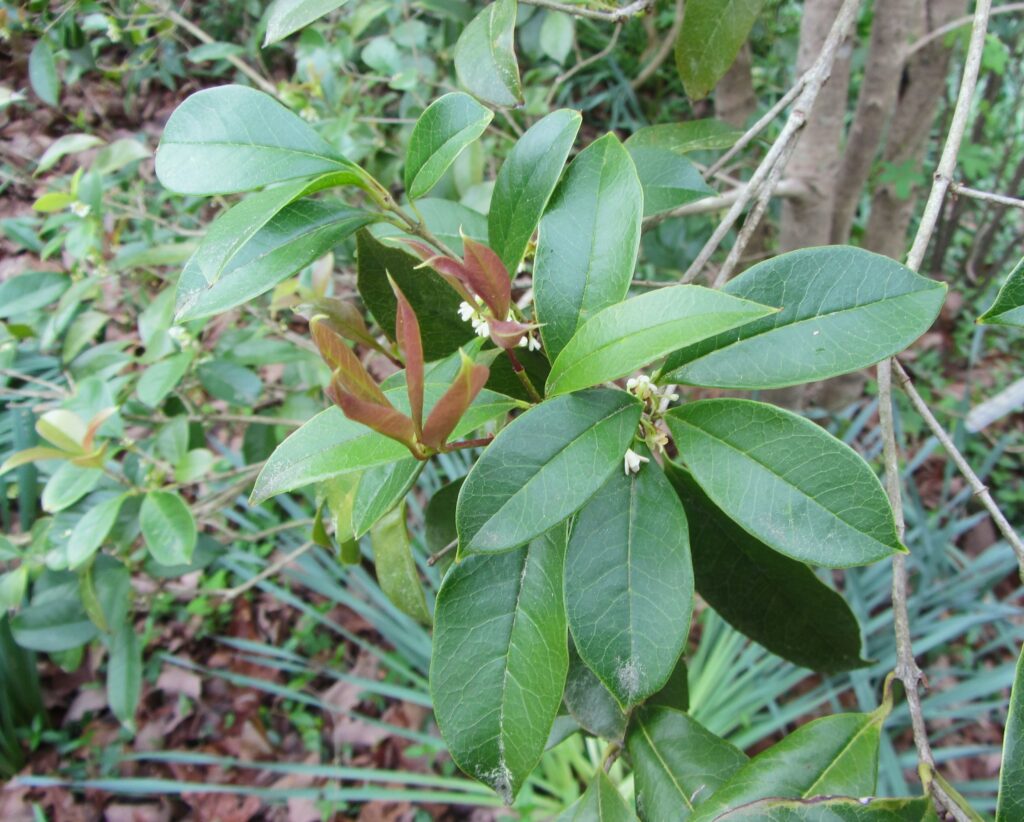
Tea olive, Osmanthus fragrans
Evergreen Shrubs with Insignificant Flowers
Evergreen shrubs with small glossy leaves may be the most familiar and popular sort of plant used in hedges and foundation plantings. While boxwood is a classic choice in many different countries, boxwood blight is a disfiguring fungal disease, easily spread, and it frequently kills the entire plant. Since boxwood blight appeared in our area around 2011, homeowners have been more interested in exploring some of the other options that look much like box and grow with a similar habit. While some cultivars and hybrids of all of these shrubs may be sterile, the species generally have very small, fragrant flowers that develop into seed bearing capsules or drupes.
Buxus sempervirens and B. microphylla FS, PS, MS, Dr Fine textured, glossy, evergreen, elliptical leaves carried neatly in opposite pairs on fine textured twigs gives Buxus an elegant and refined appearance. Sempervirens means ‘evergreen,’ and microphylla means ‘small leaved.’ B. microphylla, originally from Japan, grows slowly and will remain small with little pruning. B. sempervirens, sometimes called ‘American Boxwood’ originates in Europe east to Iran and south to Northern Africa and will grow to 20’ tall. These are a great choice for hedges, borders around planting areas, topiary, and even green walls in larger gardens. Usually very easy to grow and adaptable, these plants have very shallow roots and should be kept mulched, particularly in summer. Deer and rabbits rarely graze box, and they offer little support for wildlife beyond shelter.
Ilex– yaupon, American, English, Japanese, Chinese, inkberry, winterberry, possumhaw FS, PS, Dr, DT, WS, WF The drupes are poisonous if ingested. Some holly species are native, others originate in Europe or Asia. Many popular selections are hybrids.
Evergreen holly is another classic landscaping choice and there are hundreds of selections, species, hybrids, and cultivars on the market. Most are broadleaf evergreen shrubs, some with prickles on their leaves, and all are dioeceous. Plant both male and female trees for the females to produce fruit. Small flowers bloom in fragrant clusters in late winter and early spring. Native deciduous possum haw and winterberry hollies shine in the winter landscape, even without evergreen leaves. Yaupon holly leaves may be dried and processed for tea. Native yaupon and inkberry holly and Japanese holly have small oval leaves, without prickles, and make excellent substitutes for boxwood. Some English and American holly may be variegated. Shrubs are available in many different sizes and forms, including low ground cover shrubs. Holly grows as an understory tree in forests and will survive in deep shade, even if the best berry production is in full to partial sun. Yaupon holly is a native coastal species that will even grow on sand dunes and beaches and is salt tolerant. Holly berries may be crimson, dull red, orange, white or black, depending on their species. Hybrids of Chinese holly are popular with landscapers because of their beautiful, glossy leaves that may emerge red or pink in the spring. Holly has very high wildlife value because it supports pollinators, hosts some insect larvae, feeds birds and small animals, and provides excellent habitat for wildlife. This is a tough, adaptable shrub for low-maintenance landscapes.
Myrica Swamp Bayberry, Southern Wax Myrtle, Northern Bayberry FS, PS, WS, DT, WF, N Wax myrtle produces tiny blue or grey berries that can be rendered for their wax. Leaves and berries are very fragrant. While these small trees can be pruned, they have a rather rangy and wild appearance when left unpruned. They have high wildlife value for pollinators, as hosts for insects, as food for birds and small animals, and as habitat. Deer rarely graze them because of the essential oils in their leaves. They are very flammable and should be grown at a distance from homes and garages.
Osmanthus FS, PS, Dr, WS, DT, WF, prefers moist, acidic soil. Only one species, American Olive, is native. The other popular species are Asian. Tea olive is beloved for its fragrant flowers and beautiful leaves. Left unpruned, most selections will grow into small trees to around 20’, but this shrub can be pruned frequently to maintain its size and shape. Most species and hybrids, like Osmanthus ‘Goshiki,’ which looks like a variegated holly, are very slow growing. This is a tough plant that stands up to heat and humidity and it is ignored by deer.

Native Hydrangea quercifolia ‘Snow Queen’
Deciduous Flowering Shrubs
Chaenomeles FS, PS, Dr, WS, DT, WF, prefers moist acidic to neutral soil. There are several species and modern hybrids available, including the Proven Winner series of double flowered shrubs which lack both thorns and fruit. Often called ‘Japanese flowering quince,’ C. speciosa bears edible fruit. Flowering quince is exceptionally showy when in bloom, which may begin in February in our area and continue into May. Flowers colors include white, pink, scarlet, orange, and some blended white and pink flowers. Leaves may hold on deep into winter, and new leaves may emerge red or copper. This shrub supports pollinators, provides habitat for songbirds, responds well to pruning, and is very long-lived and dependable, thriving in summer heat and humidity. It does produce suckers which should be removed if you don’t want a shrub to turn into a thicket. Prune immediately after the shrub finishes blooming.
Cornus flowering dogwood, pagoda dogwood, Red Twig Dogwood, FS, PS, MS, Dr, N, WF, prefers moist acidic to neutral soil. While flowering dogwood, pagoda dogwood, and even Kousa dogwood (Asian) are considered small trees, red twig dogwood and several other Cornus species are used as large shrubs. These graceful trees flower in mid to late spring and drupes follow by late summer. They are ornamental in all seasons, with most species also having exceptional autumn color before their leaves fall. Some Cornus species have scarlet, orange, or yellow woody twigs, particularly in winter. Flowering dogwood, available with white, pink, or sometimes red flowers (bracts), is subject to a variety of pest and disease problems, including anthracnose, powdery mildew, blights and cankers. Dogwoods grow best as understory trees and don’t tolerate air pollution in urban areas. Dogwoods serve as host plants for butterflies, their flowers support specialized bees, butterflies and other pollinators, a wide variety of small animals depend on their fruits, and deer may graze leaves and twigs, especially on young plants. Prune after bloom to control size; prune dead or damaged wood in early spring. Next spring’s buds are already set by autumn.
Hibiscus FS, PS, Dr, DT, MS, N, WF Although most native Hibiscus are herbaceous perennials, Asian Rose of Sharon and Confederate Rose grow as deciduous shrubs. Showy Chinese Hibiscus shrubs aren’t hardy in our area, but can be grown outside in summer and sheltered during the winter in containers. All Hibiscus have very large, showy, saucer or funnel shaped flowers in shades of red, white, pink, purple or ‘blue’ that attract hummingbirds, butterflies, bees, and other pollinators. Rose of Sharon blooms from early summer through mid-fall. Seed capsules produce scores of seed per capsule, which feed birds, squirrels, and other small animals through the winter until following spring. Fertile selections will self-seed, so choose a sterile hybrid or cultivar if you don’t want seedlings. Native Hibiscus may grow to 7’ tall or more in a season, appearing like a shrub through the summer months. Stems may be slightly woody but die back to the ground each winter. New growth in early summer is rapid, leaves are large, and flowers bloom for several weeks. Prune in late winter or early spring to provide winter seeds for wildlife, but prune in autumn to control spread. Hibiscus blooms on new wood.
Hydrangea FS, PS, SH, MS, Dr, N, WF There are more than 70 species of Hydrangea, plus hundreds of named cultivars, hybrids, and selections. Most modern Hydrangeas have been selected for flower size and color and many are trademarked. The pH of the soil will influence flower color in the older H. macrophylla, mop-head or lace-cap Asian Hydrangea shrubs. Alkaline or sweet soil will result in pink flowers, acidic soil turns the flowers blue, and more neutral soil may result in purple flowers. Most Hydrangeas have large leaves, particularly the native oakleaf Hydrangea with sports large panicles of white or pink flowers all summer. This large shrub’s leaves turn scarlet in the fall and flowers persist through the winter. Smooth, or wild Hydrangea, also native, was used medicinally for various purposes by Native Americans in Eastern North America. Panicle or Peegee Hydrangea, of Asian origin, has become very popular as a small flowering tree or large shrub because it is tolerant of full sun, air pollution, and is hardy to Zone 3. All Hydrangeas support pollinators, several support butterfly species, and those that aren’t sterile produce seeds eaten by songbirds. Control the size of Hydrangeas by pruning after they bloom.
Viburnum FS, PS, SH, Dr, MS, DT, WF, N most prefer moist, acidic to neutral soil With over 150 species of Viburnum originating all over the Northern Hemisphere, there is tremendous variety in size, flower type, fruit type, and cultural preferences within this genus. Some Viburnums with very showy flowers may be mistaken for Hydrangeas, or other flowering shrubs. Flowers are most often white, and all are followed by drupes in fall. Some species, like native arrowwood Viburnum, set edible drupes that may be eaten raw or cooked in many ways, and some native Viburnums were used medicinally by Native Americans. Prune after flowering to control the shrub’s size, or limb plants up as they grow to train as a small tree. These plants have high wildlife value as host plants, pollinator plants, for habitat within their dense canopies, and as an autumn and winter food source for songbirds and small animals. Deer may graze leaves and twigs.
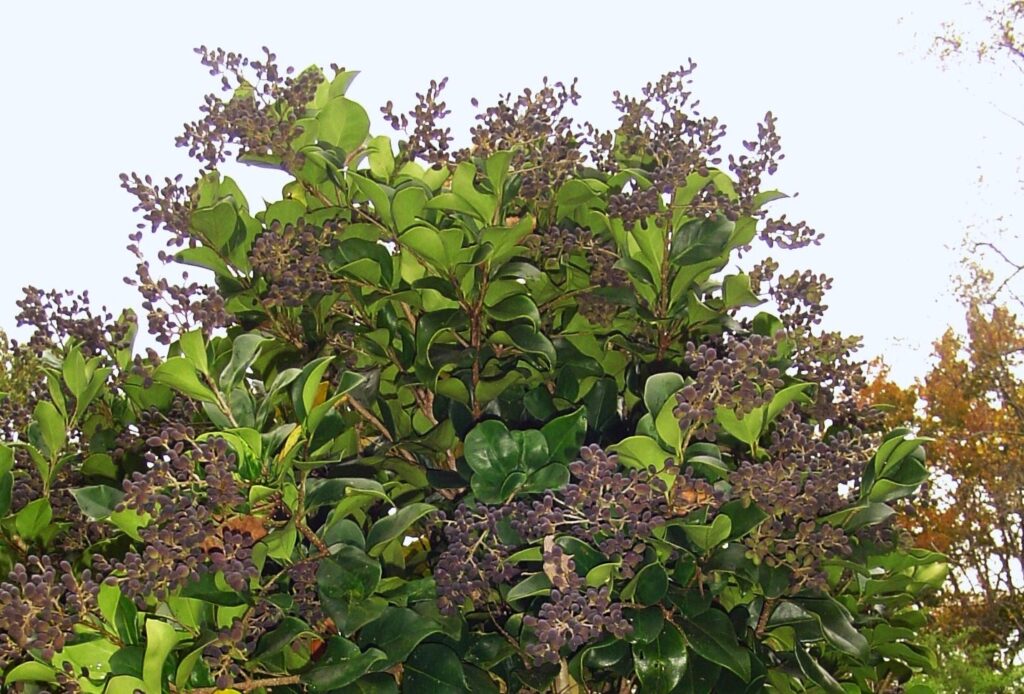
Japanese privet covered in ripe fruit in November 2013
Popular but Invasive Shrubs
These shrubs once were the darlings of horticulture, widely available and heavily advertised by mail-order nurseries. Some, like autumn olive, were even recommended by the USDA for erosion control and to clean up polluted sites. All support bees and other pollinators in spring and are highly attractive to birds and other wildlife as their fruits ripen. They provide excellent, dense wildlife habitat. Most came to be considered invasive once birds spread their seeds far and wide.
These shrubs all ‘naturalize’ easily and may become ‘weedy.’ They outcompete most native plants. If you have one, you will probably find seedlings elsewhere in your yard. But birds spread their seeds to parks, roadsides, your neighbors’ yards, and other uncultivated areas, too. Because these shrubs are tough and persistent, tolerate a wide range of cultural conditions, and grow relatively disease free, they succeed where other shrubs may fail. Because they are Asian and not native, they have earned the label of ‘invasive’ species and government agencies now discourage planting them. In fact, horticultural authorities recommend their removal, and replacement with another woody species. There are multiple species and named cultivars within each genus, and in some cases certain species are labeled ‘invasive’ while others are not.
Ligustrum FS, PS, Dr, DT, WF (Olive family) Both Chinese and Japanese privet have been mainstays of residential landscapes for decades. Native to Europe, Asia, and North Africa, these handsome, evergreen shrubs will grow into small trees if not pruned regularly. Panicles of white flowers in late spring become clusters of dark purple berries by autumn, sustaining birds and small animals through the winter. Both leaves and fruits are poisonous to humans. These pollution tolerant, tough shrubs thrive in urban areas. Some types are used in Chinese medicine. Common privet has been used as a substitute for boxwood. Consider these substitutes: American fringetree (deciduous), Holly (evergreen)
Elaeagnus (Olive family) FS, PS, Dr, WF Autumn olive, Russian olive, and thorny olive are deciduous fast growing shrubs or small trees with extensive roots. They sucker, spread and are difficult to eradicate once established. They fix nitrogen on their roots and absorb heavy metals and other pollutants, improving the soil. Some are salt tolerant and can grow on sand, loam or clay in poor conditions other shrubs could not surive. Autumn olive fruits are edible and high in vitamins and minerals. All species provide wildlife habitat in their dense, woody structures.
Consider these substitutes: Ebbing’s Silverberry (a hybrid) or tea olive, Osmanthus fragrans
Berberis thunbergii (Barberry family) FS, PS, DT, MS, Dr, WF Japanese barberry grows into a dense, rounded shrub with variously colored, or even variegated, fine-textured leaves. Varieties with reddish or burgundy leaves are particularly popular. Barberry is extremely heat tolerant, easy to transplant, and tolerates dry sites like the yards of newly built homes. Its colorful foliage make it attractive and ‘unusual’ while its high tolerance for urban growing conditions make it dependable. It has a medium growth habit and needs little pruning. Birds eat its fruits, and the spiny, sharp texture of its twigs provides habitat protection for nesting.
Consider this substitute: Ilex vomitoria ‘Bordeaux’
Euonymus alatus (Bittersweet family) FS, PS, DT, MS, Dr, WF Burning bush turns flaming crimson in autumn and is dotted all over with shiny crimson fruits. It may grow into a sprawling 20’ tall and wide suckering thicket if not pruned. Once the fruits ripen, it is alive with happily singing birds feasting on its fruit and sheltering in its thick, twiggy growth. All parts are poisonous if ingested. The genus Euonymus has about 140 species, some of which are native to Eastern North America. While the showy Asian species is chosen by landscapers for its fall color, a close relative, strawberry bush or hearts a’ busting, is a native shrub with similar fruits and growth habit that is also very popular with songbirds. Both shrubs have relatively fine, elliptical deciduous leaves and both have good fall color. Flowers are insignificant. Both grow well as understory shrubs and are very adaptable to different soils. Keep Euonymus pruned to control its size. Native strawberry bush will also naturalize from seeds spread by birds. While deer will graze leaves and twigs, all parts of these shrubs are poisonous if ingested by humans.
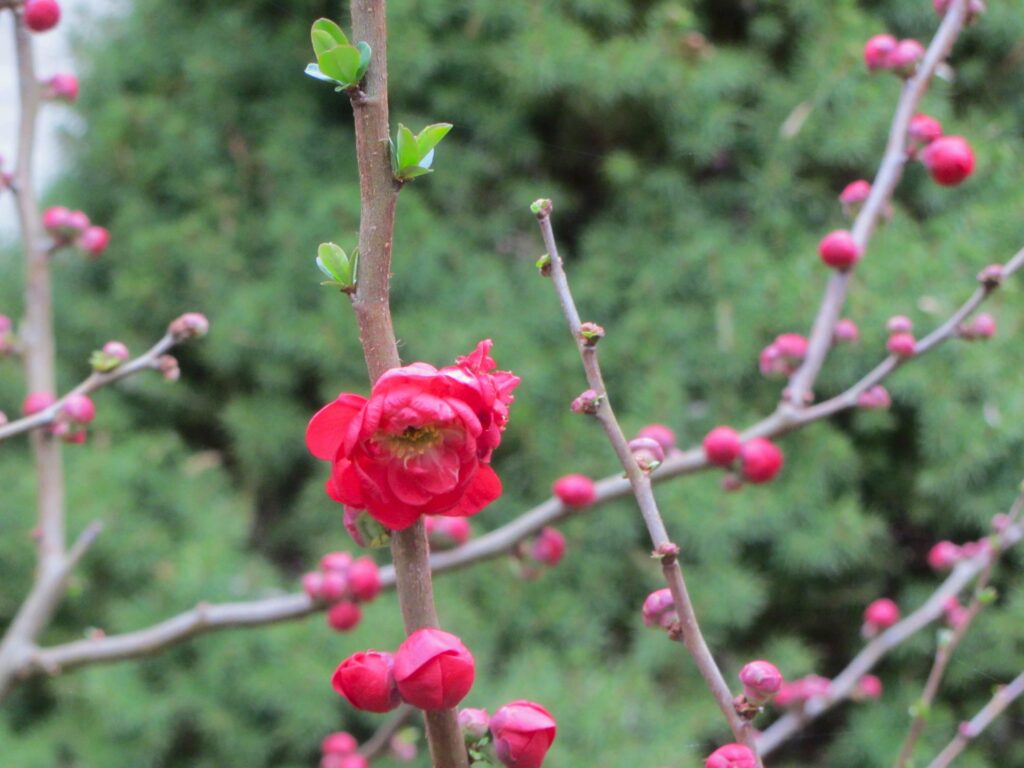
Scarlet Storm Flowering Quince blooms from February through May
All Photos by Elizabeth McCoy, Master Gardener Tree Steward
For More Information:
Arvay, Clemens G. The Biophilia Effect: A Scientific and Spiritual Exploration of the Healing Bond Between Humans and Nature. Sounds True Publishing. 2018.
Dirr, Michael A. Dirr’s Encyclopedia of Trees and Shrubs. Timber Press. 2011.
Dirr, Michael A and Keith S. Warren. The Tree Book: Superior Selections for Landscapes, Streetscapes, and Gardens. Timber Press. 2019.
Hemenway, Toby. Gaia’s Garden: A Guide to Home-Scale Permaculture. Chelsea Green Publishing. 2009.
Martin, Tovah. “Boxwood is a garden workhorse. Here’s how to protect it from blight.” The Washington Post. October 17, 2023. Accessed 4.24 https://www.washingtonpost.com/home/2023/10/17/boxwood-blight-prevention/
Mellichamp, Larry and Will Stuart. Native Plants of the Southeast. Timber Press. 2014.
Mollison, Bill. Permaculture: A Designer’s Manual. Ten Speed Press. 1997.
Scott, Timothy Lee. Invasive Plant Medicine: The Ecological Benefits and Healing Abilities of Invasives. Healing Arts Press. 2010.
Tallamy, Douglas and Rick Darke. Bringing Nature Home: How You Can Sustain Wildlife with Native Plants. Timber Press. 2009.
Tallamy, Douglas. Nature’s Best Hope: A New Approach to Conservation That Starts in Your Yard. Timber Press. 2015.
The Colonial Williamsburg Foundation. “Boxwood Blight Strikes Colonial Williamsburg.” News release. September 16, 2021.
Vogt, Benjamin. A New Garden Ethic: Cultivating Defiant Compassion for an Uncertain Future. 2017.
Virginia’s Invasive Plant List.
Virginia Tech Department of Communications and Marketing College of Agriculture and Life Sciences. “Best Management Practices for Boxwood Blight in the Virginia Home Landscape.” version 2, 2016. Accessed 4.24. https://www.pubs.ext.vt.edu/content/dam/pubs_ext_vt_edu/PPWS/PPWS-29/PPWS-29-pdf.pdf

